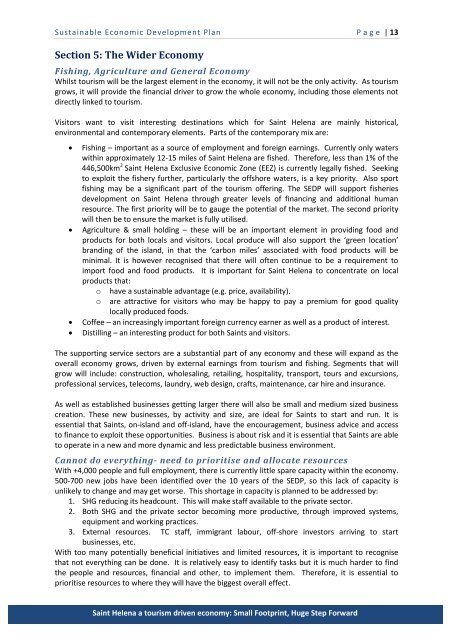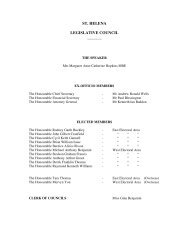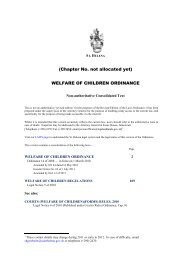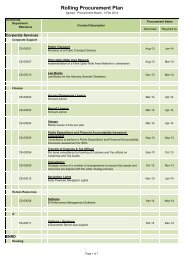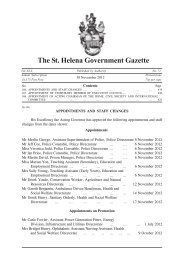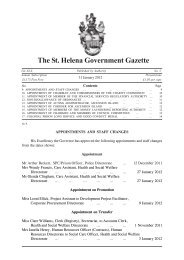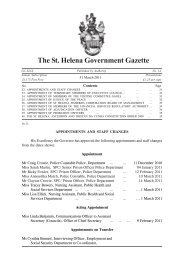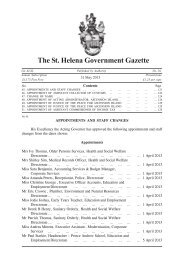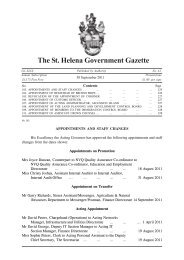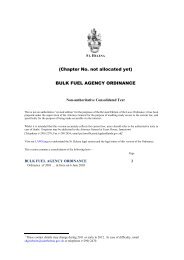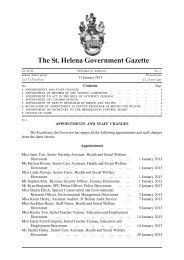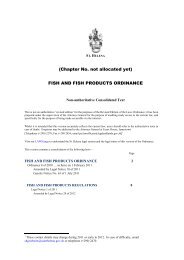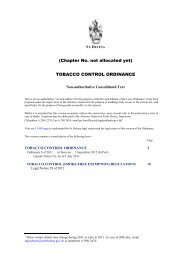Sustainable Economic Development Plan 2012/13 - St Helena
Sustainable Economic Development Plan 2012/13 - St Helena
Sustainable Economic Development Plan 2012/13 - St Helena
You also want an ePaper? Increase the reach of your titles
YUMPU automatically turns print PDFs into web optimized ePapers that Google loves.
<strong>Sustainable</strong> <strong>Economic</strong> <strong>Development</strong> <strong>Plan</strong> P a g e | <strong>13</strong><br />
Section 5: The Wider Economy<br />
Fishing, Agriculture and General Economy<br />
Whilst tourism will be the largest element in the economy, it will not be the only activity. As tourism<br />
grows, it will provide the financial driver to grow the whole economy, including those elements not<br />
directly linked to tourism.<br />
Visitors want to visit interesting destinations which for Saint <strong>Helena</strong> are mainly historical,<br />
environmental and contemporary elements. Parts of the contemporary mix are:<br />
<br />
<br />
<br />
<br />
Fishing – important as a source of employment and foreign earnings. Currently only waters<br />
within approximately 12-15 miles of Saint <strong>Helena</strong> are fished. Therefore, less than 1% of the<br />
446,500km 2 Saint <strong>Helena</strong> Exclusive <strong>Economic</strong> Zone (EEZ) is currently legally fished. Seeking<br />
to exploit the fishery further, particularly the offshore waters, is a key priority. Also sport<br />
fishing may be a significant part of the tourism offering. The SEDP will support fisheries<br />
development on Saint <strong>Helena</strong> through greater levels of financing and additional human<br />
resource. The first priority will be to gauge the potential of the market. The second priority<br />
will then be to ensure the market is fully utilised.<br />
Agriculture & small holding – these will be an important element in providing food and<br />
products for both locals and visitors. Local produce will also support the ‘green location’<br />
branding of the island, in that the ‘carbon miles’ associated with food products will be<br />
minimal. It is however recognised that there will often continue to be a requirement to<br />
import food and food products. It is important for Saint <strong>Helena</strong> to concentrate on local<br />
products that:<br />
o have a sustainable advantage (e.g. price, availability).<br />
o are attractive for visitors who may be happy to pay a premium for good quality<br />
locally produced foods.<br />
Coffee – an increasingly important foreign currency earner as well as a product of interest.<br />
Distilling – an interesting product for both Saints and visitors.<br />
The supporting service sectors are a substantial part of any economy and these will expand as the<br />
overall economy grows, driven by external earnings from tourism and fishing. Segments that will<br />
grow will include: construction, wholesaling, retailing, hospitality, transport, tours and excursions,<br />
professional services, telecoms, laundry, web design, crafts, maintenance, car hire and insurance.<br />
As well as established businesses getting larger there will also be small and medium sized business<br />
creation. These new businesses, by activity and size, are ideal for Saints to start and run. It is<br />
essential that Saints, on-island and off-island, have the encouragement, business advice and access<br />
to finance to exploit these opportunities. Business is about risk and it is essential that Saints are able<br />
to operate in a new and more dynamic and less predictable business environment.<br />
Cannot do everything- need to prioritise and allocate resources<br />
With +4,000 people and full employment, there is currently little spare capacity within the economy.<br />
500-700 new jobs have been identified over the 10 years of the SEDP, so this lack of capacity is<br />
unlikely to change and may get worse. This shortage in capacity is planned to be addressed by:<br />
1. SHG reducing its headcount. This will make staff available to the private sector.<br />
2. Both SHG and the private sector becoming more productive, through improved systems,<br />
equipment and working practices.<br />
3. External resources. TC staff, immigrant labour, off-shore investors arriving to start<br />
businesses, etc.<br />
With too many potentially beneficial initiatives and limited resources, it is important to recognise<br />
that not everything can be done. It is relatively easy to identify tasks but it is much harder to find<br />
the people and resources, financial and other, to implement them. Therefore, it is essential to<br />
prioritise resources to where they will have the biggest overall effect.<br />
Saint <strong>Helena</strong> a tourism driven economy: Small Footprint, Huge <strong>St</strong>ep Forward


